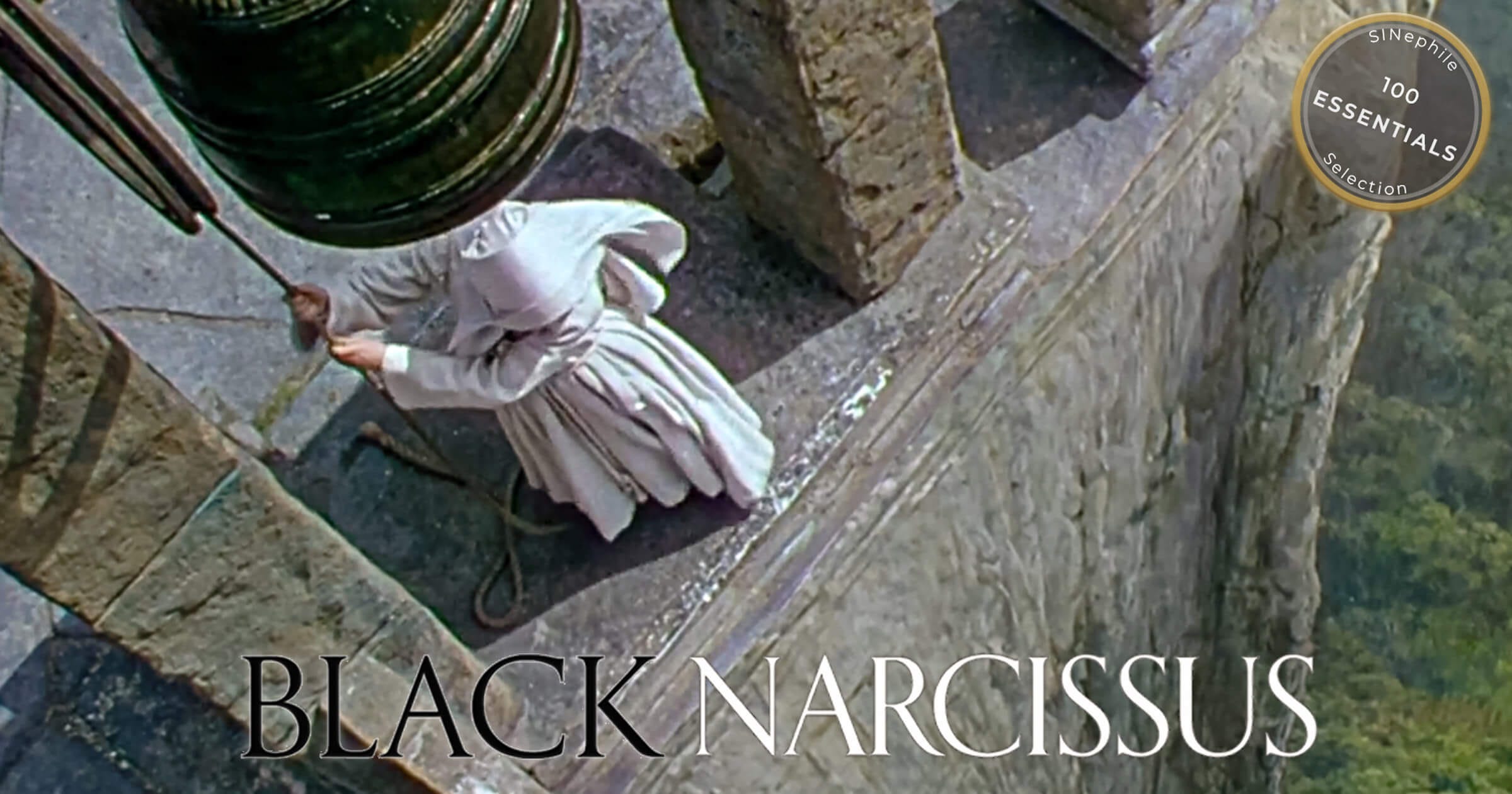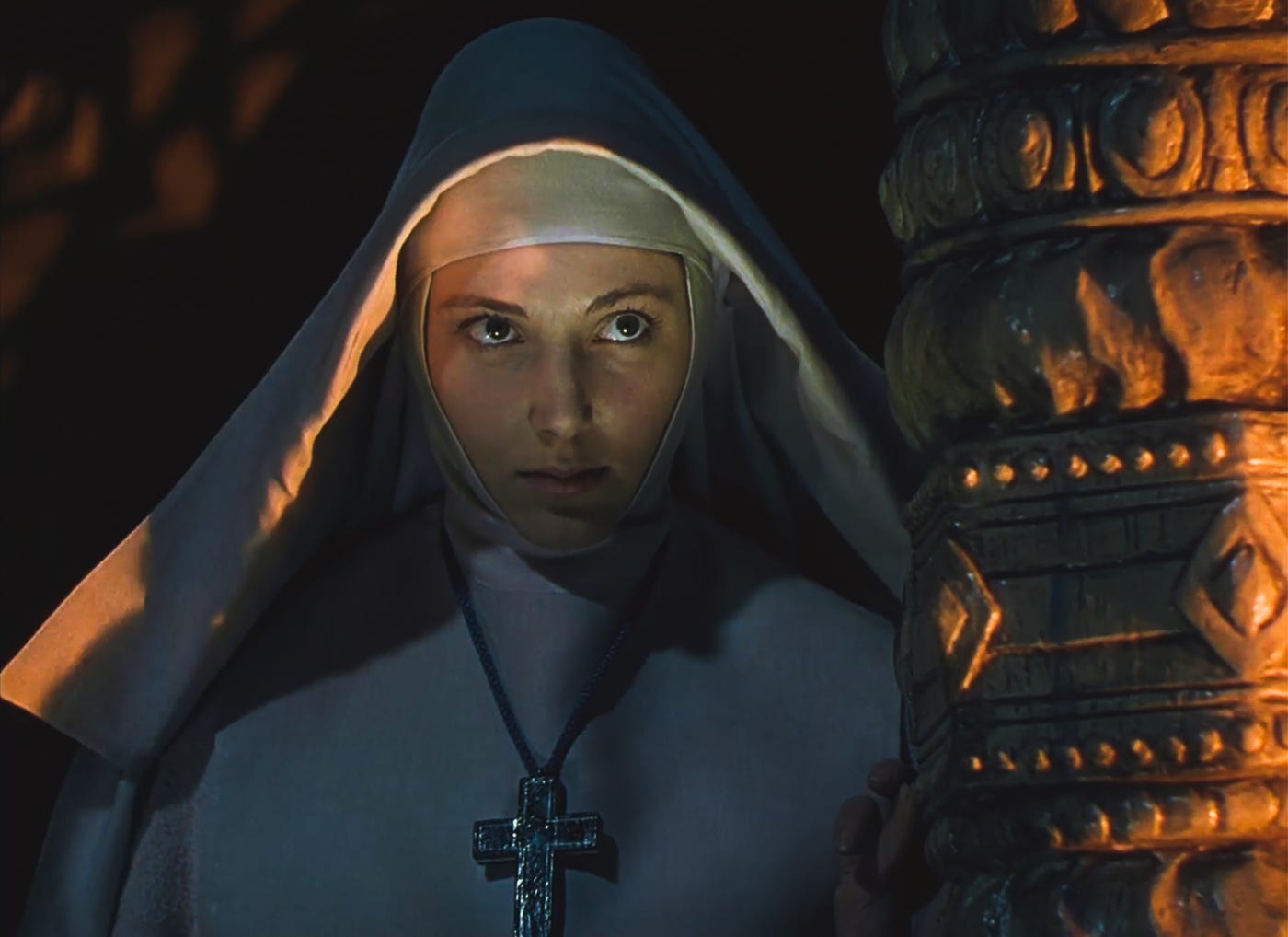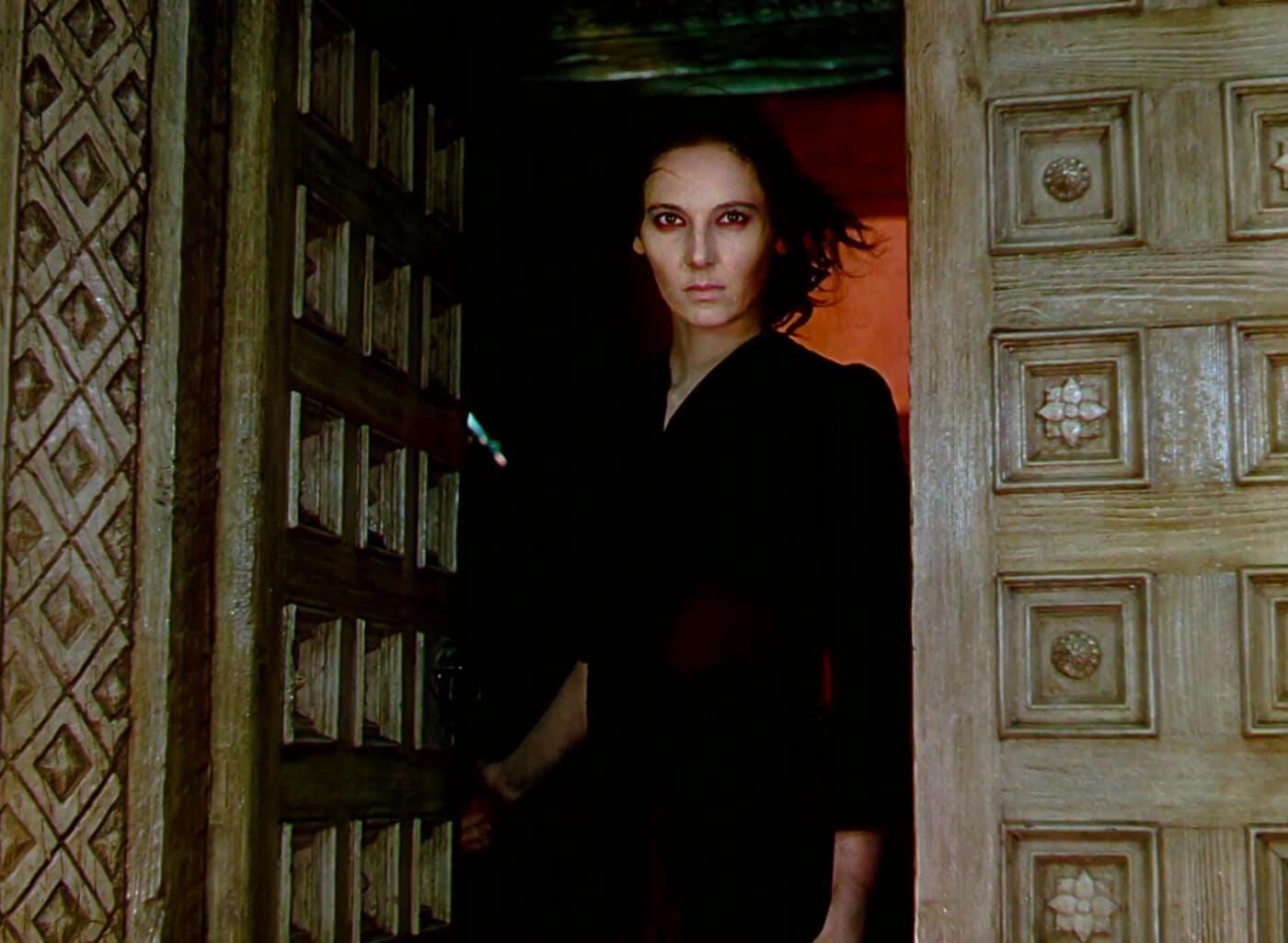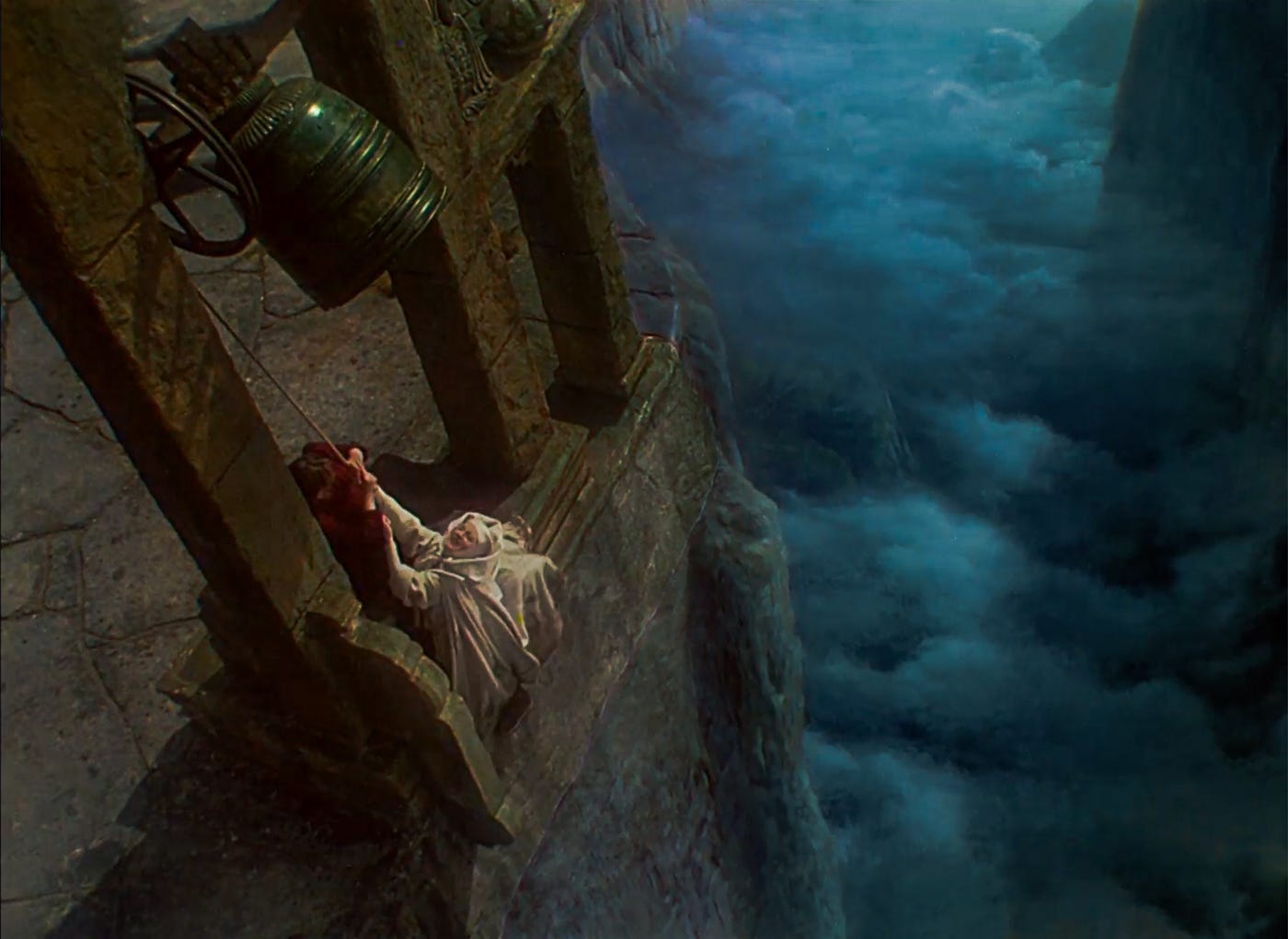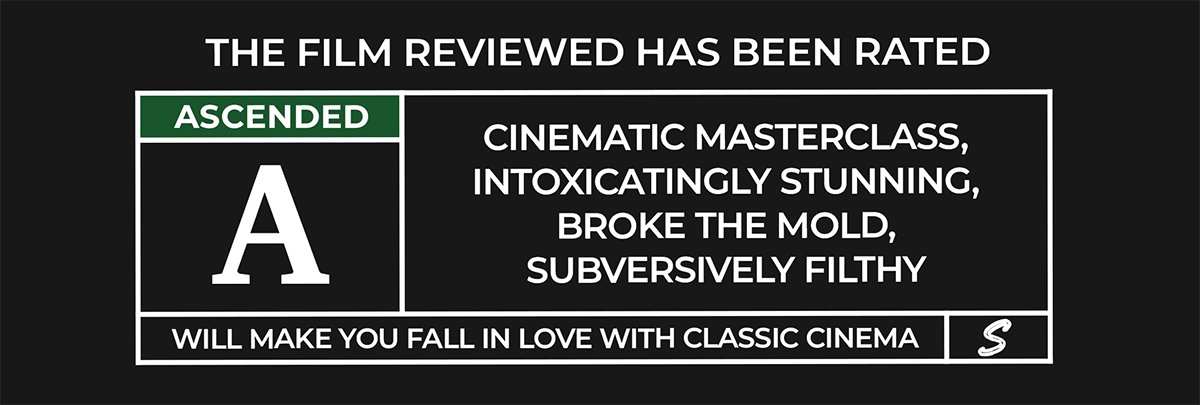🎧 [PLAYBACK: SOUND ON]
Your musical accompaniment is Brian Easdale’s bombastic score taking us from opening majestic swells to creeping existential dread.🟢 Start devotional. End deranged. Or just crank up the full OG Black Narcissus soundtrack on Spotify.
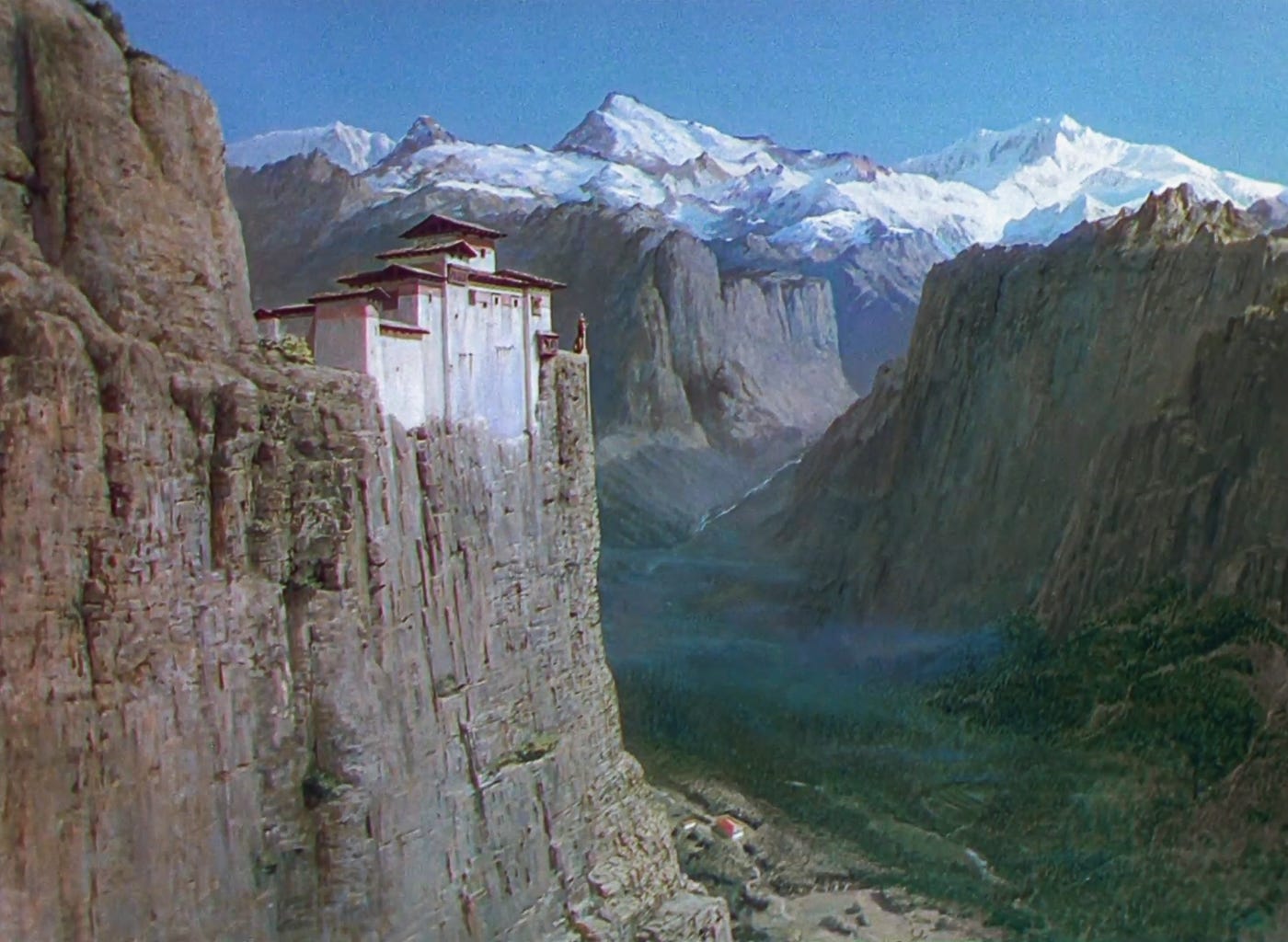
The Holy Grail of Technicolor
Hands down one of the most visually striking films ever committed to celluloid, Black Narcissus is the ultimate Powell & Pressburger collaboration and a spectacle that holds up remarkably well almost 80 years after release.
Jack Cardiff's sumptuous Technicolor cinematography and Alfred Junge's painstakingly inventive production design — both of which set a new industry standard—whimsically transport us from the Pinewood Studios backlot to an abandoned clifftop palace high in the Indian Himalayas, where an inexperienced group of five Anglican nuns is sent to establish a school and hospital for the villagers residing in the valley below.
Upon arrival, they learn the backstory of their imposing, windswept new home was as a harem for the prior Raja and that they are yet another in a long line of religious orders attempting to convert the palace for more respectable purposes, all other previous efforts ending in failure.
Powder Keg in a Convent
With each of the sisters soon experiencing unexpected effects attributed to their new location, their work proves increasingly challenging.
Most notably, the nascent attraction that develops between Sister Superior Clodagh (Deborah Kerr) and the local general's agent, Mr. Dean (David Farrar), spawns jealousy and resentment in Sister Ruth (Kathleen Byron), who is suffering from increasing mental instability.
Ironically, the film’s unconventional love triangle was directly mirrored off-screen: Byron was married director Michael Powell’s current mistress; Kerr, a recent ex.
Sister Clodagh begins the film with poise, precision, and the illusion of control. She arrives with her orders intact and her emotions sealed off. But the palace has its own plans. The wind never stopping, the serenity turning oppressive, the memories, once manageable, start arriving uninvited.
Her earlier life in Ireland flickers in with warmth and familiarity, tethered moments that feel less like memory than dislocation, as if she’s witnessing a version of herself she no longer recognizes. As her newfound leadership becomes labor, faith turns brittle and Clodagh starts to soften.
She’s mourning the person she used to be. Her spiritual unraveling is driven by shame, loneliness, and a profound crisis of identity. So, when everything starts to slip — Ruth, the school, the mission — it’s already too late to recover the steadfast resolve that once protected her.
Follow SINephile free for more bold movie judgment and delirious color palettes. No penance required.
Sister Ruth, on the other hand, unravels operatically in fragments—beads of sweat, glances held just a moment too long, the sudden edge in her reply when Clodagh gives an order. Tension builds quietly until it starts to distort her entire presence.
Kathleen Byron moves like she’s a silent film villainess wound too tight, motion staccato while framed in firelight and shadow. By the final reel, she’s devolved into something truly elemental with eyes that sear straight through the screen as the film turns from slow-burn melodrama to full-bore horror.
Powell frames Ruth less as a monster and more like the manifestation of Clodagh’s repression, stripped of all shame and unbound by doctrine. He shoots her like a force of nature ready to burn the whole system down.

Censors Missed the Sausages
While Black Narcissus contains a startling level of eroticism for a film made in 1947, I've always been bemused that the scenes censored until its 1988 restoration and re-release were primarily to remove Sister Clodagh's innocuous flashbacks to her earlier layperson memories that dared blasphemously imply that a nun could've had a life prior to marrying Christ.
The rampant phallic and yonic decor adorning the palace walls, a local prostitute who seduces multiple male characters rocking the name "Kanshi," the nuns' diet consisting solely of sausages, and Sister Ruth casting aside her habit in favor of fire-engine red lipstick and matching f**k-me pumps, were all apparently too subtle for the braintrusts who ran the Hays Code at the time.
Color Me Faithful
Scorsese has frequently cited Black Narcissus as a key formative influence, especially in its use of color, mood, and composition. He’s called it one of the most visually stunning films ever made — and a major inspiration throughout his career.
I entirely get it. Discovering Black Narcissus in college left me so transfixed I wrote a 25-page paper on it that my professor, critic Joel Siegel, had me read in front of the class — and in many ways, that assignment became the unlikely catalyst toward working at Criterion a few years later. Some films just get under your skin and stay there.
However, I’ve always been irked by the persistent color instability — most noticeably in the nuns’ habits, which Powell described as “oatmeal” but flicker between beige and grey as if the film can’t decide what neutral means.
Even the best restorations I’ve seen (discussed in PLAYBACK: Legacy below) haven’t fully solved it, suggesting the issue may lie in the original exposure or the Technicolor separations themselves. For the love of god, can someone please give this masterpiece the color stability it finally deserves?
Of course, the true brilliance of Black Narcissus remains how it critiques colonial arrogance and overreach not just through character, but in composition. Even before the nuns fail spiritually, they’ve failed visually. Their pale habits and austere rituals are swallowed whole by a landscape that’s too vivid, too alive, too sensual for stereotypical British restraint.
The convent never stood a chance. Not against the weather. Not against memory. Not against color.
TEMPTATION TALLY:
+ 1 point for Ayah, that "faithful, dirty old bird"
- 1 point for Sister Briony’s coffee-making skills, but + 4 points for actress Judith Furse bringing unapologetic butch energy to the convent
+ 5 points for functioning as a biting anti-colonial allegory in the waning days of British rule
+ 10 points for initially getting Condemned by the Catholic Legion of Decency
An essential picture and a mainstay in my Top 10.
Postscript: Don't bother with the painfully unnecessary and ill-advised 2020 BBC/FX mini-series remake. Black Narcissus is an artifact of the time in which it was made and should remain as such.
Share this review with anyone who thinks Technicolor is just an Instagram filter. And if it stunned you too, tap like or leave your favorite convent meltdown in the comments below.
DOUBLE FEATURE DETOUR:
Intoxicated by Black Narcissus? Try pairing it with Paul Verhoeven’s spectacular camp trainwreck about Vegas strippers. Find out why they’re shockingly twisted siblings in the full Split Screen showdown, if you dare.
📊 [PLAYBACK: RECEPTION]
Budget: £280K ($1.2M) in 1947. That’s $15M today.
Original UK Box Office: £85K ($340K), ~$4.2M adjusted.
*Adjusted as of 2025Cinema DEFCON Threat Level:
37 years — Theatrical-to-Video WindowVerdict
Underperformed financially—but overdelivered on influence, legacy, and lasting aesthetic impact. The numerous restorations and revivals over the years have cemented Black Narcissus as a one of the most important and lasting celebrations of the cinematic experience. Hence, easily lands at DEFCON 5.
⏳ [PLAYBACK: LEGACY EDITION]
1988 – Janus Films U.S. Re-release with Restored Footage
Previously censored scenes—originally cut following condemnation by the Catholic Legion of Decency—were reinstated for theatrical screenings in the U.S.1988 – Criterion Collection Debut
Criterion released Black Narcissus on LaserDisc, featuring a letterboxed transfer and supplemental materials, including audio commentary by directors Michael Powell and Martin Scorsese.
2001 – Criterion DVD
This DVD edition ported over content from the LaserDisc, offering improved accessibility for home viewers.2008 – ITV Blu-ray Restoration
ITV Studios issued a digitally restored edition on Blu-ray in the UK, helping reintroduce the film to home audiences.
2010 – Criterion Blu-ray
Criterion released their own restoration on DVD and Blu-ray, including new supplements, with an HD transfer supervised by Powell’s widow (and Scorsese’s longtime editor) Thelma Schoonmaker.2023 – BFI 35mm Tour: Cinema Unbound
The British Film Institute organized nationwide UK screenings of new 35mm prints as part of its “Cinema Unbound” retrospective celebrating Powell and Pressburger.2025 – Eye Filmmuseum 4K Theatrical Showcase
A new 4K restoration was screened in Amsterdam during the Eye Filmmuseum’s Creative Worlds of Powell and Pressburger retrospective—apparently its most pristine version yet, though not yet released to video or streaming.
🎬 [PLAYBACK: TRAILER]
The mesmerizing modern trailer created by editor Dan McBride for his YouTube channel, DM Edit. All of his creations are bangers, but I first discovered his long-running project on the strength of this standout.
Share this review with someone who needs reminding that repression always finds its escape hatch. Does Black Narcissus stun you too? Tap like or drop your favorite aspect of the film in the comments.


